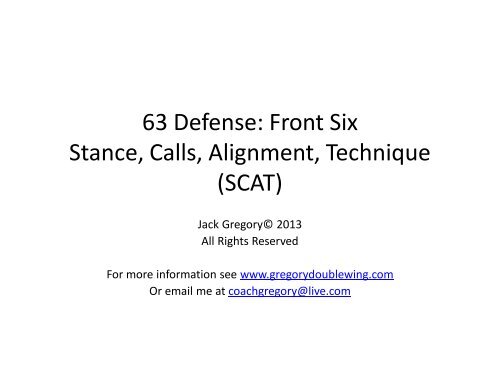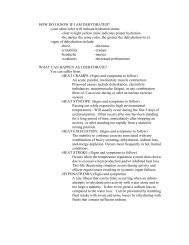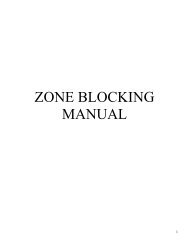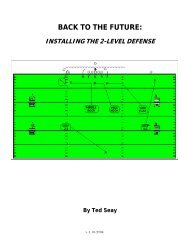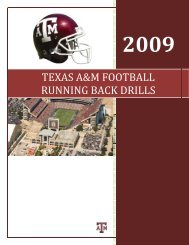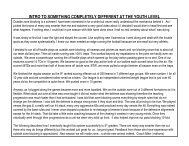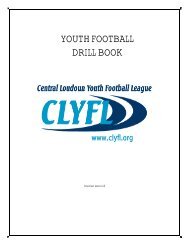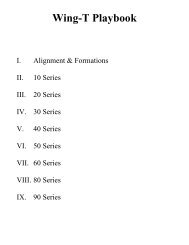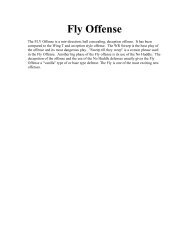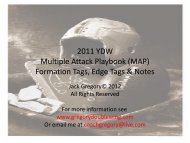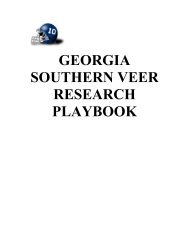Front Six (SCAT) - Gregory Double Wing
Front Six (SCAT) - Gregory Double Wing
Front Six (SCAT) - Gregory Double Wing
Create successful ePaper yourself
Turn your PDF publications into a flip-book with our unique Google optimized e-Paper software.
63 Defense: <strong>Front</strong> <strong>Six</strong><br />
Stance, Calls, Alignment, Technique<br />
(<strong>SCAT</strong>)<br />
Jack <strong>Gregory</strong>© 2013<br />
All Rights Reserved<br />
For more information see www.gregorydoublewing.com<br />
Or email me at coachgregory@live.com
<strong>Front</strong> <strong>Six</strong><br />
• Stop the ball from moving vertical up the field via<br />
the A, B, and C gaps.<br />
• Compress the Line of Scrimmage and collapse the<br />
backfield forcing the ball to spill or redirect. (play<br />
behind the heels of the blockers and locate the<br />
ball).<br />
• Defensive linemen are gap contain players. Fill<br />
gap, collapse LOS, and locate and flow to the ball<br />
with near shoulder leverage.<br />
• OLB’s penetrate their gap and attack the near hip<br />
of the QB. They are gap pressure players.
Terms<br />
• Ball Get Off: Ability to react quickly and explosively to<br />
the first movement (key) by they offense. You move<br />
when the ball/foot/hand moves.<br />
• Fingers to ball alignment: Getting the defensive line to<br />
get their fingertips on the line of scrimmage.<br />
• Pre-snap relaxed: relaxed, not tense, and ready to get<br />
off the ball on first movement.<br />
• Hat in crack: Get your hat and foot in the gap you are<br />
responsible for as fast as possible.<br />
• Pull Stop: technique for beating trap blocks as well as<br />
pulling guards and tackles.
Gap Fit & Integrity<br />
GAP FIT: each defensive lineman and outside backer is responsible for a interior gap whether they are in STACK<br />
or RED based call.<br />
In STACK the OLB will attack through his gap to the QB’s near hip. In RED or RED based call he will read AT in his<br />
GAP/HOLE/WINDOW.<br />
Notices below that each defender has an assigned gap except our MIKE who will FIT on the inside of the ball as<br />
it comes AT him or AWAY from him.
Leverage<br />
• Defensive line men must always maintain near shoulder leverage on the ball. Once they<br />
locate the ball they attack the ball but maintain near shoulder leverage on the ball by doing<br />
this it limits the runner’s ability to move.<br />
• If each defensive linemen fits properly and penetrates their gap and then locates the ball and<br />
maintains near shoulder leverage they eliminate the four of the six interior gaps leaving one<br />
gap on each side for their OLB.<br />
• Near side shoulder leverage simply means that once you penetrate and locate the ball you<br />
keep the ball on that shoulder by expanding or contracting as the ball moves.
Defensive Linemen<br />
• Must be consistent!<br />
• Must finish every play!<br />
• Know your job and do it!<br />
• Play with great technique every play!<br />
• These don’t require talent just hard work!
<strong>Front</strong> <strong>Six</strong> Traits<br />
• OLB: more athletic players of your F6 players. The better football player &<br />
athlete he is the more you can do with him. He should be a pretty good leader<br />
(stacks), and he should have decent quickness and aggressiveness. The better<br />
he is in zone and man coverage and the better he is at tackling the more you<br />
can do with him.<br />
• DT: the more athletic of the two defensive linemen. Can be two types, small<br />
aggressive penetrators that are hard to block or big boys that can fill a gap and<br />
penetrate with power. In either case they must be able to compress the LOS.<br />
• DG: the least athletic F6 player but follow the guidelines for tackles.<br />
• Special note: if you have an elite defensive linemen don’t be afraid to move<br />
him from DT to DG and even from stack to another to keep the offense<br />
guessing.<br />
• Special Adjustment Player:<br />
– NT (Nose Tackle): elite defensive player that can either penetrate aggressively and<br />
quickly or fill a gap with power or BULL/2Gap and fill space on the LOS.<br />
– ROVER (second MIKE): Same as the MIKE backer and often a ROVER type player<br />
becomes part of BACK 5.
Defensive Line Technique #1<br />
• Alignment – crowd the line of scrimmage.<br />
Finger to ball alignment.<br />
• If head up align nose to nose.<br />
• If GAP – align right in the middle of the gap no<br />
matter the split between linemen. HEAD IN<br />
CRACK fast!
Defensive Line Technique #2<br />
• Stance – three point stance, down hand claw the<br />
grass as you explode off the ball. use a three –<br />
point stance that is aggressive.<br />
• By aggressive I mean that you need to use a toe –<br />
instep (or slightly deeper) staggered stance with<br />
the dominant hand down and around 18 to 24<br />
inches from the up field foot.<br />
• The offhand needs to be in a power position as if<br />
ready to sprint; cocked above and behind the<br />
near hip.<br />
• Best described as an aggressive sprinters stance.
Defensive Line Technique #3<br />
• Exploding off the ball is essential and the first<br />
step is key; it needs to be an aggressive power<br />
step into the gap.<br />
• It is alright to teach the down hand on the slant<br />
side as well and often is an advantage if you can<br />
teach them to get into a stance using both hands<br />
but the key is comfort so they can get off the ball<br />
fast.<br />
• Get off on first movement. Ball moves you move.<br />
• Move on movement not sound/noise. Must be<br />
trained and be clear on what they move on.
Defensive Line Technique #4<br />
• Throw your body into the hole.<br />
• Get your nose, head, shoulders, and foot into<br />
the hole. If you get them in the hole you will<br />
get behind their heels.<br />
• First step is with back foot and replaces your<br />
down hand. Next step is in the hole.<br />
• Explode forward.
Defensive Stances for DG/DT/NG
OLB Stance<br />
• Outside Backer: Will get in a balanced two point stance with the<br />
feet slightly shoulder width apart. The arms cocked with elbows<br />
over or just past the knees and hands up. Hips and knees bent so<br />
there and the chest over the knees. He should be slightly on the<br />
balls of his feet and he should be in a solid hitting stance ready to<br />
move in any direction.<br />
• He should be the most athletic player in the stack. The play side<br />
outside linebacker is the Alley defender and the backside outside<br />
linebacker is the Bounce the defender.<br />
• If the outside linebacker is on the line of scrimmage and blitzing he<br />
will use an aggressive 2 point stance (defensive end stance).<br />
• This is s stand up staggered two point stance with outside foot<br />
back, hips and knees bent. The chest is over the front knee and<br />
head is up with arms cocked and ready.
OLB Stance
Stack Concept<br />
• Remember the line of scrimmage is made up of eight gaps and the stack<br />
concept basically acts like a GAP 8 defense in that we are going to<br />
penetrate all eight of those gaps in STACK call.<br />
• Who we use to penetrate each gap will vary from play to play based on the<br />
stack call on each side.<br />
• Because we are using stacked backers the way in which we penetrate is<br />
actually a wave or layered effect so the offensive line will have a very hard<br />
time simply down blocking the entire front and washing the defenders<br />
away from the play.<br />
• Basically the center, guard, tackle, and end will never know which three<br />
defenders they are going to face on the interior and which gap they will<br />
hit. This often causes issues with RULE BLOCKING SCHEMES and ZONE<br />
BLOCKING SCHEMES. Especially with younger players still trying to master<br />
stances, get off, technique along with rule assignment identification. The<br />
movement of the stacks represent a real problem for these teams.
Stack = Pressure<br />
• This is a pressure concept that allows us to attack with eight defenders putting players<br />
in every gap and closing down the backfield from the D gap as our force defender hunts<br />
the ball from the outside in.<br />
• When we call stack we want to attack; we want those six stack defenders getting behind<br />
the LOS as quickly as possible, locating the ball, and killing the ball behind the LOS or<br />
spilling the ball into the hunters. OLB hunts the near hip of the QB.<br />
• We want our defensives ends hunting the ball from outside in and either stopping the<br />
ball in the backfield or spilling it deep behind the LOS towards the boundary.<br />
• Very simple and used with young or inexperienced teams to teach defensive concepts.
How the Stacks Work #1<br />
• The outside backers will make a stack call which will tell the other two<br />
members of the stack where to go and what to do.<br />
• Each defensive linemen has one rule while in the stack when the ball is<br />
snapped they must penetrate into the backfield through their gap as fast<br />
as possible; penetrate past the heels and compress the LOS, and then<br />
locate the ball. GET OFF THE BALL, GET BEHIND THE HEELS, LOCATE THE<br />
BALL, GET TO THE BALL.<br />
• OLB has a bit more freedom due to their athletic ability. They penetrate<br />
past the LOS and attack the near hip of the QB. This allows us to put<br />
immediate pressure on the ball from one gap while the remaining<br />
defenders in the stack compress the LOS.<br />
• The outside backers are free to make any basic call and you should<br />
encourage them to change up and vary the calls as much as possible.<br />
Teach them that they should call plays that will get them to the QB as fast<br />
as possible. The OLB should be attacking the worst/weakest blocker on his<br />
side and based on the BASE POINT OF ATTACK of the offense.
How the Stacks Work #2<br />
• What you will find is as the outside backers and the defensive linemen<br />
take owner ship of the stack that the outside backers will make calls that<br />
will get them in the backfield as quickly as possible as they will hit the gap<br />
that is the most available to them to get to the ball. They will often attack<br />
the weak spot so you get strength against a weak spot.<br />
• Because the stunting and blitzing is layered, meaning defenders are<br />
attacking the LOS at various moments in time, it ensures that a runner<br />
cannot simply bypass the first level of our defense because they have to<br />
pass the layered pressure coming through the interior gaps (A,B,C).<br />
• Defensive linemen stay square and close on the ball if the ball goes past<br />
them vertically they must retrace to their gap in the same path they<br />
travelled. This ensures that we reduce cut back lanes on the interior and<br />
maintain near shoulder leverage.
How the Stacks Work #3<br />
• If the ball goes outside the near side DT will close down from inside<br />
out maintaining spacing on the near side DE. The DG will form<br />
above the DT and the backside DG will maintain spacing above the<br />
play side DG, and the backside DT will maintain spacing above the<br />
backside DG. This creates a wall of defenders that close down on<br />
the ball. If in RED the BOUNCE OLB is sitting on top of the ball if the<br />
ball carrier tries to cut back and go vertical as he is forced up the<br />
wall.<br />
• If a offensive linemen vacates (pulls) the defensive linemen follows<br />
his rule he penetrates and locates the ball. If the ball flows with the<br />
vacating linemen he squeezes down on the hip of the offensive<br />
linemen as he goes to the ball square.<br />
• Defensive linemen must maintain near shoulder leverage on the<br />
ball.
Basic Calls<br />
SPLIT GAP<br />
IN<br />
OUT<br />
BASE CALL (GOAL LINE/OPEN END)<br />
BASE CALL
Basic Calls<br />
These four basic calls can be made by the OLB’s at any time. My rule to them is put<br />
yourself in the best position to make a play on the ball. Find the weak leak in the<br />
line and hammer that call home while keeping the offense on their toes.<br />
• IN – The OLB will call IN and it will tell both the DG and DT to slant to the inside<br />
gaps (A and B) while the OLB stunts into the C gap.<br />
• OUT – The OLB will call OUT and it will tell both the SG and DT to slant to the<br />
outside gaps (B and C) while the OLB stunts into the A gap.<br />
• SPLIT – The OLB will call SPLIT and it will tell DG slant into the inside gap (A) and<br />
the DT to take the outside gap (C) while the OLB stunts into B gap.<br />
NOTE: These three calls allow the OLB to hit all three gaps on his side of the ball.<br />
GAP – short yardage/goal line call. AUTO CALL against open ends – immediate<br />
pressure in the backfield.
Stack Penetration Technique<br />
• The way they will penetrate into the gap is the defensive<br />
linemen will put their eyes on the hands or feet of the blocker<br />
in front of them or the ball (whichever is easier). When their<br />
key moves their hands/feet or the ball moves they will get off<br />
the ball by exploding into their gap (BGO – Ball Get Off). Fall<br />
into the gap….<br />
• The OLB will be keying backfield through the line. First<br />
movement they move.
Stack Penetration Aiming Points<br />
Outside Backer Defensive Tackle Defensive Guard<br />
IN<br />
Aims off the defensive tackle’s<br />
outside hip at the snap and attacks<br />
first window. Head in the crack. Aims<br />
for the QB’s near hip. Just like the<br />
DE but hunting the QB<br />
IN<br />
Eye on your movement key. It<br />
moves you move. Penetrate through<br />
the inside hip of the blocker you are<br />
over. Get behind the heels and<br />
locate the ball.<br />
IN<br />
Eye on your movement key. It<br />
moves you move. Penetrate through<br />
the inside hip of the blocker you are<br />
over. Get behind the heels and<br />
locate the ball.<br />
OUT<br />
Aims off the defensive guard’s inside<br />
hip at the snap and attacks first<br />
window. Head in the crack. Aims for<br />
the QB’s near hip. Just like the DE<br />
but hunting the QB<br />
OUT<br />
Eye on your movement key. It<br />
moves you move. Penetrate through<br />
the outside hip of the blocker you are<br />
over. Get behind the heels and<br />
locate the ball.<br />
OUT<br />
Eye on your movement key. It<br />
moves you move. Penetrate through<br />
the outside hip of the blocker you are<br />
over. Get behind the heels and<br />
locate the ball.<br />
SPLIT<br />
Aims off the defensive tackle’s inside<br />
hip at the snap and attacks the first<br />
window. Head in the crack. Aims for<br />
the QB’s near hip. Just like the DE<br />
but hunting the QB<br />
SPLIT<br />
Eye on your movement key. It<br />
moves you move. Penetrate through<br />
the outside hip of the blocker you are<br />
over. Get behind the heels and<br />
locate the ball.<br />
SPLIT<br />
Eye on your movement key. It<br />
moves you move. Penetrate through<br />
the inside hip of the blocker you are<br />
over. Get behind the heels and<br />
locate the ball.<br />
GAP<br />
Aligns inside of the DE in a two point<br />
DE stance snug to the first blocker<br />
inside. Aims for the QB’s near hip.<br />
Just like the DE but hunting the QB.<br />
GAP<br />
Aligns in side of the blocker he is<br />
over splitting the distance between<br />
his blocker and the next. Eye on your<br />
movement key. It moves you move.<br />
Get behind the heels and locate the<br />
ball.<br />
GAP<br />
Aligns in side of the blocker he is<br />
over splitting the distance between<br />
his blocker and the next. Eye on your<br />
movement key. It moves you move.<br />
Get behind the heels and locate the<br />
ball.
Engagement/Shed Technique<br />
• All the stack players must get off the ball quickly on the first movement<br />
they see (whether that is the ball or the hand/foot of any of the near<br />
blockers). This is called BGO (BALL GET OFF).<br />
• Secondly they must stay low and pierce the LOS. As they attack through<br />
the gap hip (aiming point) they must use the far arm and rip under and<br />
through the blocker if he attempts to block him. He must not get tangled<br />
up with any blocker as his job is to penetrate behind the heels of the<br />
blocker and then locate the ball and flow to it.<br />
• Go-Rip-Flow should be their three step progression. The key is to get into<br />
the gap and then penetrate behind the heels of the line and then locate<br />
the ball in that exact order.<br />
• The RIP technique can be a speed rip or rip & club (wrist, elbow, shoulder).<br />
The key is it has to be violent and explosive and allow the defender to<br />
create separation quickly. Part of our DEFENSIVE SHED FIT at the<br />
beginning of practice.
Be Aware!<br />
• Aggressiveness is good but being overly<br />
aggressive is not good.<br />
• Penetrate past the heels of the offensive line.<br />
• Locate the ball.<br />
• Move to the ball as square to the LOS as<br />
possible.<br />
• If the ball carrier goes vertical and moves past<br />
you retrace your steps to your gap then<br />
pursue.
Thoughts On Stack Personnel<br />
• If you have extra talent or you feel you have a very<br />
talented and/or gifted OLB or even defensive linemen<br />
don’t hesitate to put them in the stack.<br />
• Although I feel that having your superior talent in the<br />
hourglass (BACK 5) is essential to stopping the big plays<br />
you can improve the pressure you place on the offense<br />
by placing natural talent in those positions and letting<br />
them pin their ears back and get after the ball.<br />
• Good talent in the stacks will also improve your force<br />
on the edges from your ends as well and increase the<br />
likelihood of a turnover in the pass triangle from the<br />
increased pass rush pressure.
<strong>Front</strong> <strong>Six</strong> Advanced Calls<br />
• These are advanced calls for the front six and they give us some nice variations that allow us<br />
to give a few different looks and twist in attacking offensive lines.<br />
• BEAR is really a simplification of our interior line that allows us to look like GAM team as it<br />
places the guards and tackles in the A and B gaps and bear crawl them through while the<br />
OLB’s align in the C gaps and blitz but we can call RED BEAR and have the OLB’s read as well.<br />
Nice call for younger age teams or inexperienced (MPP) players.<br />
• The BULL uses the LAUNCH IN LAP technique with all four defensive line men attacking the<br />
guards and tackles while the OLB’s align in the C gap and blitz. It is basically a TWO GAP<br />
technique that aggressively displaces the blocker into the backfield. We can also call RED<br />
BULL to have the OLB’s read. This is a great call for offensive lines that are basically sitting on<br />
their gaps trying to cover up their gaps expecting stunting and blitzing off our stacks. If<br />
offensive lines are area blocking and not coming off aggressively this is a great call because it<br />
gets the defensive linemen into the blockers and drives them off the line of scrimmage as<br />
they read flow.<br />
• TWISTER (IN call with a line stunt) and TORNADO (OUT call with a line stunt) are nice<br />
adjustments to teach if you have some athletic linemen that can move laterally quickly and<br />
then get up field with some discontent in their heart. These could both be with the OLB<br />
reading calling them RED TWISTER and RED TORNADO.<br />
• TIGER is a stunt between the two defensive guards while the defensive tackles attack the B<br />
gaps and the OLB’s can either blitz the C gaps or READ (RED TIGER).
GAP CALLS<br />
• This is a blend of the basic calls and GAP.<br />
• IN + GAP = GAP IN<br />
• OUT + GAP = GAP OUT<br />
• SPLIT + GAP = GAP SPLIT<br />
• OLB has the same hunting landmark: near hip of the QB.<br />
• GAP modification – This is a short yardage and/or instant pressure call<br />
when we need to get all three defenders into the backfield immediately.<br />
This is especially useful in short yardage and goal line situations and when<br />
we want pressure in the gaps now.<br />
• DG and DT slide into the middle of their slant gap.<br />
• OLB drops into the middle of his gap in a two point sprinter stance.
GAP Calls<br />
GAP SPLIT GAP IN<br />
GAP OUT
Bear Call<br />
• The BEAR call allows you to use less than athletic linemen and fill space so<br />
it is really an adjustment to adapt to slower linemen.<br />
• The defensive line align in the gaps with the defensive guards aligning in<br />
the A gaps and the defensive tackles in the B gaps while the OLB’s align in<br />
the C gap and blitz into the backfield.<br />
• The bear crawlers must explode into the gaps and crawl past the heels of<br />
the blockers. As soon as they do they must get their heads up and locate<br />
the ball immediately and get up and get to the ball.<br />
Bear<br />
Red Bear
Bull Call<br />
• The defensive linemen get into a four point power rush stance and they<br />
literally spring into the lap of the blocker and drive him back into the<br />
backfield as they locate the ball.<br />
• If executed correctly they are playing a two gap technique in a very<br />
aggressive manner. It is essentially a flat out explosive bull rush.<br />
• It is a great change up against offensive lines that are sitting on the line of<br />
scrimmage trying to locate which guy to block. The BULL call also will<br />
allow the OLB to come free in the C gap if the TE fans out to take the DE<br />
and does not block the OLB or on the open side.<br />
Bull<br />
Red Bull
Bull Rush Technique<br />
(Launch in Lap)<br />
• Four Point Stance – aggressive lean.<br />
• Explode into the chest plate of the blocker and<br />
power punch into the arm pits and drive the<br />
blocker back.<br />
• Head up, locate ball, pound feet, drive blocker<br />
back.<br />
• Locate ball, pull/push away blocker, square up,<br />
go to ball.
Twister Call<br />
• Twister is an inside blitz to the A gap while the defensive guard drops their outside foot and<br />
crosses over the inside foot as the body stays square to the line of scrimmage. The defensive<br />
tackle will aim for the outside hip of the next blocker inside (guard) and attack through the<br />
gap just as if he was slanting into the B gap. As soon as the defensive tackle penetrates the<br />
defensive guard will cross the face of the defensive tackle’s blocker (tackle) and penetrate<br />
past the blocker’s outside hip. The defensive guard must stay flat and literally scrape the<br />
defensive tackle as he goes by so that he can get into the smallest space possible on the<br />
outside hip of the offensive tackle.<br />
• The OLB must attack the inside hip of the offensive guards and go through it. If the OG fans<br />
out to follow the defensive guard or blocks into the B gap to pick up the DT he leaves the A<br />
gap open and OLB will be behind the LOS quickly especially if the center is focused on the<br />
opposite stack.<br />
Twister<br />
Tornado
Tornado Call<br />
• Tornado is the exact opposite to Twister. The OLB will blitz into the C gap aiming for the<br />
outside hip of the offensive tackle. The defensive guard will aim for the inside hip of the<br />
offensive tackle and slant into the B gap. The defensive tackle will drop his inside foot and<br />
cross over step with his outside and scrape the defensive guard as he goes into the B gap. As<br />
soon as the DG goes vertical and he crosses the defensive guard’s butt the defensive tackle<br />
will go vertical and attack the inside hip of the offensive tackle and get into the C gap.<br />
• This is a great call against offensive guards that are chasing the defensive guard into the B gap<br />
as well as a nice call for when the offensive tackle is stepping down inside to cover the B gap<br />
as the stunt will lure him inside so the OLB can get into the C gap easily.<br />
Twister<br />
Tornado
Red Twister/Tornado Call<br />
• The addition of RED the OLB’s don’t blitz into their designed gaps instead they fake the blitz<br />
and read. This is a nice complimentary call to Twister and Tornado and very easy to install if<br />
you already have the RED call installed.<br />
• It is great way of adding additional pressure on the inside and the DE is providing sufficient<br />
pressure on the edge so the OLB can read and respond to a good backfield attack.<br />
Red Twister<br />
Red Tornado
DOT Call<br />
• DOT call tells DT to drop into zone coverage as if a LB (same drop rule). The OLB and DG<br />
follow same rules and can be altered via other calls.<br />
• Bull Dot tells the DG to use a BULL technique and the DT to drop into zone coverage (LB zone<br />
drop).<br />
• This is a call we use in conjunction with our STACK, SPREAD, and other calls. Not used with<br />
RED.
DOG Call<br />
• DOG call tells the DG to drop into zone coverage as if a LB.<br />
• Bull Dog tells the DT to use a BULL technique and the DT to drop into zone coverage (LB zone<br />
drop).<br />
• This is a call we use in conjunction with our STACK, SPREAD, and other calls. Not used with<br />
RED.
Basic Training for the <strong>Front</strong> <strong>Six</strong><br />
• Stack Drills:<br />
– Stance<br />
– Alignment<br />
– Recognition and Calls<br />
– Technique<br />
• Get off<br />
• Shed & Penetration<br />
• Pull Stop<br />
• Pass Rush<br />
• Pursuit Lanes
Stance Drill #1 (Stance & Alignment)<br />
• Why: To teach the basic stances and foundations of the defensive line and outside backers.<br />
• How: Coach will align them on a basic seven cones (tires) set up with the center cone being the center.<br />
Teach the two point balanced linebacker stance and the proper depth (1 to 4 yards) . Teach the defensive<br />
linemen how to get into a proper 3-point Then teach them how the OLB is in charge of the stack and he<br />
makes the calls either vocally or physically (taps). Have them get into and out of their stances and check<br />
them to makes sure they are correct. Make sure the OLB depth is correct as well. Basic alignment. Check<br />
and recheck Fingers to ball alignment (tight to the LOS).<br />
C
Stance Drill #2 (Alignment)<br />
• Why: To teach the proper alignment on offensive fronts (five, six, seven, eight man fronts) and how to<br />
quickly align on balanced and unbalanced (3:3, 2:4, 1:5, 0:6). Review and cover the shift call for the above<br />
(shift, double shift, triple shift) that the mike backer can make to align the interior front. Cover the open<br />
OT and how the outside backer automatically makes the GAP (unless RED).<br />
• How: Coach will align them on various fronts with a snapper cone. Align them on a basic seven man<br />
front, six man front (GAP CALL is made on open side (no TE side), five man front (gap call made on both<br />
sides). Then have them align on an eight man front (MIKE calls shift to strong side). Then have them align<br />
on a nine man front (stay balanced). Next Step is review unbalanced sets out of a 7 man front (explain<br />
3:3, 2:4 (shift), 1:5 (double shift), 0:6 (triple shift). Explain that an eight man front that is unbalanced<br />
simply add 1 shift to the above.<br />
• NOTE: The MIKE makes a shift call it means to slide over by ONE MAN. <strong>Double</strong> shift means TWO MEN.<br />
Triple shift means THREE MEN. QUAD SHIFT means FOUR MEN (I have never had to use this but you never<br />
know when you have to adjust to a crazy formation.<br />
C
Stance Drill #3 (Recognition and Calls)<br />
• Why: To teach our basic call and later on our advance call packages. Stress BGO (ball get off)<br />
• How: Coach will take two stack teams have them quickly align, get into a proper stance, and prepare for<br />
ball/blocker movement. Once the coach quickly checks for both proper alignment and stance he will<br />
move up to the LOS and use either a foot or a ball for movement. The backers will be given a basic call (IN,<br />
then OUT, then SPLIT, then GAP) and on the movement queue they will fire off and execute that call. Once<br />
the players pass the blockers heels they will come to a full stop and the coach will check to make sure each<br />
defender is in the right gap. He should also check that they fire off on the very first movement and attack<br />
the right aiming points. The coach should teach each call separately then combine calls one at a time.<br />
Make sure to stress FINGERS TO BALL ALIGNEMNT and HAT IN CRACK.<br />
• Note: use various alignments to get the stacks used to aligning on different fronts<br />
C
Get Off Drill #1 (Technique)<br />
• Purpose: To teach our player to BGO (ball get off), penetrate behind the heels, locate the ball. Get to it<br />
square.<br />
• How: Coach Holding a ball will simulate a snap and move ball. Defenders move on the movement of the<br />
ball. They explode off the line and into their assigned gap. Defensive line must locate the ball and flow to<br />
it square. OLB’s must penetrate and attack the near hip of the QB (coach). Coach will move a few steps<br />
left, right, or towards the LOS. All defenders must flow to the coach and double tap him.<br />
• Notes: check stance, alignment, BGO technique, and LOCATE technique.<br />
• High reps, high quality. Work fast.<br />
C
Get Off Drill #2 (Technique)<br />
Purpose: To increase the BGO of the STACK TEAMS.<br />
How: Two sets of line cones set up 6 yards apart with a cone/maker<br />
in between the two center cones. Like to use two sets of STACKS<br />
facing each other. Work on 1 call at a time and then let the each<br />
separate stack team call their own call. A coach will stand in the<br />
middle and give a movement each pair is competing to get off on first<br />
movement and get behind the LOS.<br />
Nice to have four<br />
stack pairs but<br />
three or even two<br />
will work.<br />
High reps. High quality.<br />
Work fast so that they<br />
get past the heels and<br />
then quickly reset.<br />
Make call and call<br />
DOWN and move. They<br />
must BGO, HEAD IN<br />
CRACK, GET BEHIND THE<br />
HEELS.<br />
Make it competitive.
Get Off Drill #3<br />
Taken from: 1999-Cover-2-Tampa-Bay-Buccaneers-Dungy-Kiffin-DL Manual
Shed – Line Drill #1<br />
• Purpose – to work on our basic (and advance) Shed and penetrate moves. By using two lines of players;<br />
alternating between blocker and defender.<br />
• How – Two lines of blockers will face each other and pair up. One will be the blocker who will get into a 3<br />
point stance and execute a DRIVE BLOCK or PASS BLOCK and the defender will execute the called SHED and<br />
PENETRATE MOVE, HEAD IN CRACK, LOCATE THE BALL, FLOW TO THE BALL. One coach will stance behind<br />
each line the coach behind the defender will move to tell the blockers and the coach behind the blockers<br />
to BLOCK. The defenders will BGO and execute their SHED move. The coach will simply move left or right<br />
and the defenders must penetrate, locate, and get to the coach and tap him.<br />
• Can get a lot of high quality reps in a small amount of time. All defenders can, and do, do this but in<br />
FRONT SIX we have DL and OLB’s work on this.
Shed – Line Drill #2<br />
• Purpose – to work on our basic (and advance) Shed and penetrate moves. By using live blockers that are<br />
static and only offering a LOAD/EXPLODE.<br />
• How – starting cone and 4 to 5 blockers spaced 6 to 7 yards from each other and a finishing cone 5 yards<br />
away. On a movement key from the first blocker he will BGO and execute a SHED move to either side and<br />
penetrate behind the heels of the blocker. He will alternate sides as he SHEDS each blocker. When he gets<br />
by the last blocker he will rush to the finish maker and touch it (can be a player holding a tackling dummy<br />
for a tackle or a live ball carrier that goes left or right (1/2 speed) for a wrap up tackle.<br />
• One the first group is through and behind the finish cone it becomes the start cone and repeat. Then<br />
swap out the defenders and blockers and repeat. You can get a lot of high quality reps really fast this way.<br />
• Work one shed technique at t time.<br />
Speed Rip <strong>Double</strong> Block<br />
Club and Rip Single Block<br />
Chop/Dip/Rip Bull<br />
Hump Bull and Jerk
Shiver Drill<br />
• Purpose – to teach the defender how stab hands inside arm pits, lock out, and shed.<br />
• How – using two dummies stack one on top of the other length wise on the ground and each player<br />
2 yards back from the end of the dummy on each side. On GO from the coach each play will move<br />
to the #1 side and both will attempt to properly and violently shed the other. As soon as the<br />
contact is made the coach will call GO again and they will release and back to the other side and<br />
repeat their shed contact. They will do this until the coach calls STOP. Work for 3 to 5 reps on each<br />
set.<br />
1<br />
2
Single Cut Block Drill<br />
• Purpose: to teach a defender how to deal with a cut block and flow to the ball.<br />
• As you see the blocker drop his shoulder and drive into your legs you must get<br />
your eyes on him and drive your palms into his shoulder pad and get him into the<br />
ground. Then eyes on ball and continue to flow to the ball and maintain your<br />
leverage.<br />
• Rotate the three through each spot (3 reps) and then move to the next three<br />
players. Try to get three to four reps at defending the cut block for each player.<br />
Cut<br />
Tackle
Multiple Cut Block Drill<br />
• Purpose: To work on dealing with the cut block and getting multiple reps<br />
in the same drill.<br />
• Work on your punch technique and then finishing off the runner (don’t let<br />
the defender take the runner to the ground).<br />
Cut Cut Cut Tackle
Pass Rush<br />
• Why: To teach our player to convert to a pass rush to get to the passer.<br />
• How: Coach Holding a ball will simulate a snap and move ball. Defenders move on the movement of the<br />
ball. They explode off the line and into their assigned gap as if to pass rush. Defensive line must locate<br />
the ball and flow to it square. OLB’s must penetrate and attack the near hip of the QB (coach). Coach will<br />
drop 3 or 5 step and the stacks will convert to a pass rush and get to the passer. If the QB is prepared to<br />
throw and the defenders have not gotten to the passer they get their hands up and jump the ball when it<br />
leaves his hand.<br />
• Notes: make sure the DL stay in their paths and stay square on the passer. Mix up the calls.<br />
• Notes: Make sure that every defender maintains proper leverage on the passer. Once they see pass and<br />
confirm there is no dander of DRAW – no RB near the QB get vertical to the passer ASAP.<br />
• Notes: practice against quick step, 3 step, 5 step, sprint out, and bootleg so they understand leverage<br />
(near shoulder) and pursuit (gets by so form wall).<br />
C<br />
C
Retrace Path<br />
• Why: To teach our player to retrace their path when they penetrate to deep on a DRAW/DELAY/QB RUN OFF<br />
BROKEN PLAY.<br />
• How: Coach Holding a ball will simulate a snap and move ball. Defenders move on the movement of the ball.<br />
They explode off the line and into their assigned gap as if to pass rush. Defensive line must locate the ball and<br />
flow to it square. OLB’s must penetrate and attack the near hip of the QB (coach). The second coach will move<br />
down to the LOS three to four steps and yell DRAW or SCREEN and then stay center, move left, move right and the<br />
DL must retrace and get to the ball. All defenders must flow to the coach and double tap him.<br />
• Notes: check stance, alignment, BGO technique, and LOCATE technique. OLB must always hunt the near hip.<br />
C<br />
C
Push/Pull Contest<br />
• Why: to teach the DL how to execute a push/pull in a competitive arena<br />
• How: Two defenders will grasp each others arm pits and on GO both DL men will attempt to push/pull<br />
their opponent on to the ground. First defender to put their opponent on the ground wins.<br />
• You can have several pairs going at a time as long as you have one coach managing each pair.<br />
1<br />
2<br />
3<br />
C<br />
C<br />
C
Bull Rush Technique<br />
• Why: To teach our defensive linemen how to bull drive a blocker and flow to the ball.<br />
• How: using a dummy, a blocker with a shield, an cone, and a ball carrier.<br />
• 1): The DL will get in a four point stance and the blocker will be in a two point o-line stance holding a<br />
shield. When the OLINE steps forward the DL will fire off and explode directly into the blocker driving his<br />
palms into the arms pits. The purpose is to drive the blocker back as far as possible. The DL must launch<br />
violently into the blocker and when contact is made he gets his feet on the ground with a wide base and<br />
power drives the blocker back. The purpose of this drill is to master the explode portion and get the DL<br />
used to launching his body into the blocker.<br />
• 2): Same as above except we put a cone five yards back from the blocker. Now the DL will drive the<br />
blocker back past the cone. The purpose of this portion is to get the DL to get his feet down and drive the<br />
already off balance blocker back.<br />
• 3): We add a ball carrier five yards back and on blocker first move the ball carrier walks to the left or right<br />
and the DL must push-pull the blocker away and flow to the ball carrier and wrap him up.<br />
1<br />
2<br />
3<br />
C<br />
C<br />
C<br />
Explode<br />
Drive<br />
Push - Pull
Pull Stop Drill<br />
• Why: To teach our player to properly react and move on a pull block that happens in front of them when they are slanting in<br />
front or behind the pull. PULL DRIVE/PULL FOLLOW<br />
• How: Coach Holding a ball will simulate a snap and move ball. Defenders move on the movement of the ball. They explode<br />
off the line and into their assigned gap. If they SLANT IN FRONT of the pull they must attempt to get on the near<br />
hip/shoulder of the blocker and drive him into the backfield and force the ball to go deep then push/pull and get behind the<br />
heels of the puller and locate the ball. If they SLANT BEHIND the pull they must behind his heels, locate the heels and flow<br />
to the ball. If the defender slants in front of the puller and can not drive him execute a pull follow. In all cases once they<br />
penetrate the heels of the puller locate the ball and flow to it with good leverage.<br />
• Notes: Stack OLB makes a call and they execute on first movement from coach or OLINE. OLB hunts near hip but if he<br />
slants into a gap and in front of a puller he should execute a PULL DRIVE and if behind he simply gets behind and hunt the<br />
ball.<br />
• Notes: It is important they get off the ball (BGO) and immediately respond to the pull after they penetrate.<br />
C
Split the <strong>Double</strong><br />
• Why: to teach our defensive linemen how to split a double team and penetrate beyond their heels or<br />
drop the double team at the LOS if they get contact. The OLB must realize that he is free man and must<br />
get through his gap and locate the near hip of the QB.<br />
• How: Coach will signal a IN/OUT/SPLIT and on his snap count the TE/T will double team the DT and the<br />
OG/CTR will double team the DG. They must BGO and attempt to get behind the heels of the oline,<br />
square their shoulder, and locate the ball. If they get caught by the double team they must latch on to the<br />
near arm pit (cloth under arm pit) or lock both blocker’s tricep in (arm lock) into your chest and drive one<br />
knee down as they pull down on both arm pits/arms and drive the double team into the ground at the<br />
LOS creating a barrier. They must do this as soon as they realize they will not penetrate past the heels.<br />
The OLB must quickly get into his gap before the OLINE can come off their block and make a play and get<br />
to the coach.<br />
• Notes: you can use advanced calls as well in this drill as you move on into the season.<br />
C C C
Questions/Comments


